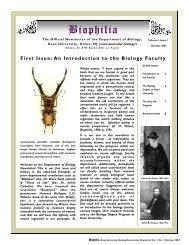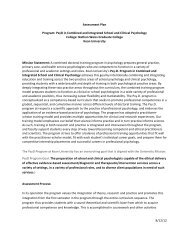GeorGe SeGal - Kean University
GeorGe SeGal - Kean University
GeorGe SeGal - Kean University
Create successful ePaper yourself
Turn your PDF publications into a flip-book with our unique Google optimized e-Paper software.
with Mondrian’s Composition, 1933, on an Easel, 1965. these are a collector, an art dealer, an<br />
artist, and an arts patron.<br />
In truth, Segal steered away from formal commissioned portraits, and they form but a small<br />
part of his body of work:<br />
…It would be relatively simple using this method [plaster casting] to make<br />
uncannily accurate portrait sculpture. Mostly portrait sculpture is aimed at<br />
putting the sitter’s best foot forward and most sitters who are paying hard cash<br />
for a portrait are not interested in psychological probing. I suppose that’s the<br />
reason I avoid straight sculptures as much as I can, unless the person posing<br />
for me is willing to accept my particular kind of treatment (which is generally<br />
kind, but not glorifying). 2<br />
A second category of depiction—and in terms of portraiture perhaps much more controversial,<br />
given the artist’s stated intentions—would be that of persons not referred to in titles but known to<br />
the viewer through secondary sources. If we happen to look through the 1979 Walker Art center<br />
(Minneapolis) catalog for George Segal: Sculptures, one would learn that the then Director of the<br />
Walker, Martin Friedman, posed as the customer in Segal’s Hot Dog Stand. Friedman’s account<br />
of that experience (“A coat of nivea cream, a lubricant, was smeared over my hands and the<br />
chest area exposed by the open shirt….”) is part of the exhibition catalog. that decidedly<br />
changes how we see the sculpture: the humble “customer” is a museum director!<br />
More dramatically, since it is Segal’s first full-scale tableaux, is The Dinner Table 1962.<br />
the models include the now well-known artist Lucas Samaras, Kaprow and the dance critic<br />
Jill Johnston. Segal is quoted as saying: “I usually make sculpture of people I know very well in<br />
situations that I’ve known them in…as long as there has been a very alive emotional experience<br />
between me and the person.” Given the history of the artist’s friendships, this would certainly<br />
apply to The Dinner Table, for these are precisely the people that might be visiting Segal at his<br />
new Jersey chicken farm during that period. the viewer might not know or care who robert<br />
and Ethel Scull were, but it might be of interest to note that Samaras and Kaprow were friends<br />
and models. then, if you happened to have met one of the artists, as I have, another level opens<br />
up. Jill Johnston, of course, I knew well, since she was the dance critic at The Village Voice<br />
where I also worked.<br />
And then there is the third level of portraiture, which is recognized only by a very few, in<br />
Segal’s case a kind of unintended portraiture attained by and seen by family, friends not in the<br />
public eye, and perhaps the intimates of a very occasional professional model. Works with first<br />
names in their titles would be closer to portraiture than those without, since specific persons<br />
2 Phyllis tuchman, George Segal, Abbeville Press, 1983<br />
5

















